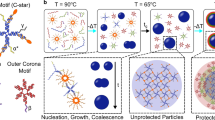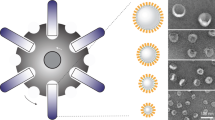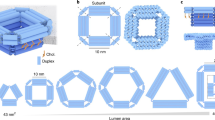Abstract
Combinatorial high-throughput methodologies are central for both screening and discovery in synthetic biochemistry and biomedical sciences. They are, however, often reliant on large-scale analyses and thus limited by a long running time and excessive materials cost. We here present a single-particle combinatorial multiplexed liposome fusion mediated by DNA for parallelized multistep and non-deterministic fusion of individual subattolitre nanocontainers. We observed directly the efficient (>93%) and leakage free stochastic fusion sequences for arrays of surface-tethered target liposomes with six freely diffusing populations of cargo liposomes, each functionalized with individual lipidated single-stranded DNA and fluorescently barcoded by a distinct ratio of chromophores. The stochastic fusion resulted in a distinct permutation of fusion sequences for each autonomous nanocontainer. Real-time total internal reflection imaging allowed the direct observation of >16,000 fusions and 566 distinct fusion sequences accurately classified using machine learning. The high-density arrays of surface-tethered target nanocontainers (~42,000 containers per mm2) offers entire combinatorial multiplex screens using only picograms of material.

This is a preview of subscription content, access via your institution
Access options
Access Nature and 54 other Nature Portfolio journals
Get Nature+, our best-value online-access subscription
$29.99 / 30 days
cancel any time
Subscribe to this journal
Receive 12 print issues and online access
$259.00 per year
only $21.58 per issue
Buy this article
- Purchase on Springer Link
- Instant access to full article PDF
Prices may be subject to local taxes which are calculated during checkout




Similar content being viewed by others
Data availability
Data supporting the findings of this study are available in the article and Supplementary Information.https://sid.erda.dk/sharelink/DWSndIUDNTSource data are provided with this paper. All data used for the paper are also available through UCPH Erda at https://sid.erda.dk/sharelink/DWSndIUDNT.
Code availability
All the code used for tracking, event finding and ML, as well as the trained ML models, are available through UCPH Erda at https://sid.erda.dk/sharelink/DWSndIUDNT and can be found in https://github.com/hatzakislab/SPARCLD.
References
Afek, A. et al. DNA mismatches reveal conformational penalties in protein–DNA recognition. Nature 587, 291–296 (2020).
Fodor, S. P. et al. Multiplexed biochemical assays with biological chips. Nature 364, 555–556 (1993).
Colin, P.-Y. et al. Ultrahigh-throughput discovery of promiscuous enzymes by picodroplet functional metagenomics. Nat. Commun. 6, 10008 (2015).
Eun Chung, S. et al. One-step pipetting and assembly of encoded chemical-laden microparticles for high-throughput multiplexed bioassays. Nat. Commun. 5, 3468 (2014).
Attene-Ramos, M. S., Austin, C. P. & Xia, M. in Encyclopedia of Toxicology (ed. Wexler, P.) 916–917 (Elsevier, 2014).
Christensen, S. M., Bolinger, P.-Y., Hatzakis, N. S., Mortensen, M. W. & Stamou, D. Mixing subattolitre volumes in a quantitative and highly parallel manner with soft matter nanofluidics. Nat. Nanotechnol. 7, 51–55 (2011).
Jahn, R. & Scheller, R. H. SNAREs—engines for membrane fusion. Nat. Rev. Mol. Cell Biol. 7, 631–643 (2006).
Solon, J., Streicher, P., Richter, R., Brochard-Wyart, F. & Bassereau, P. Vesicles surfing on a lipid bilayer: self-induced haptotactic motion. Proc. Natl Acad. Sci. USA 103, 12382–12387 (2006).
Robson Marsden, H., Elbers, N. A., Bomans, P. H. H., Sommerdijk, N. A. J. M. & Kros, A. A reduced SNARE model for membrane fusion. Angew. Chem. Int. Ed. 48, 2330–2333 (2009).
Mora, N. L. et al. Controlled peptide-mediated vesicle fusion assessed by simultaneous dual-colour time-lapsed fluorescence microscopy. Sci Rep. 10, 3087 (2020).
Löffler, P. M. G. et al. A DNA-programmed liposome fusion cascade. Angew. Chem. Int. Ed. 56, 13228–13231 (2017).
van Lengerich, B., Rawle, R. J., Bendix, P. M. & Boxer, S. G. Individual vesicle fusion events mediated by lipid-anchored DNA. Biophys. J. 105, 409–419 (2013).
Agasti, S. S. et al. DNA-barcoded labeling probes for highly multiplexed Exchange-PAINT imaging. Chem. Sci. 8, 3080–3091 (2017).
Li, Y., Cu, Y. T. H. & Luo, D. Multiplexed detection of pathogen DNA with DNA-based fluorescence nanobarcodes. Nat. Biotechnol. 23, 885–889 (2005).
Lin, C. et al. Submicrometre geometrically encoded fluorescent barcodes self-assembled from DNA. Nat. Chem. 4, 832–839 (2012).
Lin, C., Liu, Y. & Yan, H. Self-assembled combinatorial encoding nanoarrays for multiplexed biosensing. Nano Lett. 7, 507–512 (2007).
Hatzakis, N. S. et al. How curved membranes recruit amphipathic helices and protein anchoring motifs. Nat. Chem. Biol. 5, 835–841 (2009).
Stella, S. et al. Conformational activation promotes CRISPR-Cas12a catalysis and resetting of the endonuclease activity. Cell 175, 1856–1871.e21 (2018).
Bohr, S. S.-R., Thorlaksen, C., Kühnel, R. M., Günther-Pomorski, T. & Hatzakis, N. S. Label-free fluorescence quantification of hydrolytic enzyme activity on native substrates reveals how lipase function depends on membrane curvature. Langmuir 36, 6473–6481 (2020).
Neher, R. & Neher, E. Optimizing imaging parameters for the separation of multiple labels in a fluorescence image. J. Microsc. 213, 46–62 (2004).
Valm, A. M. et al. Applying systems-level spectral imaging and analysis to reveal the organelle interactome. Nature 546, 162–167 (2017).
Han, M., Gao, X., Su, J. Z. & Nie, S. Quantum-dot-tagged microbeads for multiplexed optical coding of biomolecules. Nat. Biotechnol. 19, 631–635 (2001).
Fournier-Bidoz, S. et al. Facile and rapid one-step mass preparation of quantum-dot barcodes. Angew. Chem. Int. Ed. 47, 5577–5581 (2008).
Wei, L. et al. Super-multiplex vibrational imaging. Nature 544, 465–470 (2017).
Hu, F. et al. Supermultiplexed optical imaging and barcoding with engineered polyynes. Nat. Methods 15, 194–200 (2018).
Lubeck, E. & Cai, L. Single-cell systems biology by super-resolution imaging and combinatorial labeling. Nat. Methods 9, 743–748 (2012).
Livet, J. et al. Transgenic strategies for combinatorial expression of fluorescent proteins in the nervous system. Nature 450, 56–62 (2007).
Li, M. et al. Single enzyme experiments reveal a long-lifetime proton leak state in a heme-copper oxidase. J. Am. Chem. Soc. 137, 16055–16063 (2015).
Veshaguri, S. et al. Direct observation of proton pumping by a eukaryotic P-type ATPase. Science 351, 1469–1473 (2016).
Thomsen, R. P. et al. A large size-selective DNA nanopore with sensing applications. Nat. Commun. 10, 5655 (2019).
Bendix, P. M., Pedersen, M. S. & Stamou, D. Quantification of nano-scale intermembrane contact areas by using fluorescence resonance energy transfer. Proc. Natl Acad. Sci. USA 106, 12341–12346 (2009).
Löffler, P. M. G. et al. Lipidated polyaza crown ethers as membrane anchors for DNA-controlled content mixing between liposomes. Sci Rep. 9, 13856 (2019).
Christensen, S. M., Mortensen, M. W. & Stamou, D. G. Single vesicle assaying of SNARE-synaptotagmin-driven fusion reveals fast and slow modes of both docking and fusion and intrasample heterogeneity. Biophys. J. 100, 957–967 (2011).
Haluska, C. K. et al. Time scales of membrane fusion revealed by direct imaging of vesicle fusion with high temporal resolution. Proc. Natl Acad. Sci. USA 103, 15841–15846 (2006).
Martens, S., Kozlov, M. M. & McMahon, H. T. How synaptotagmin promotes membrane fusion. Science 316, 1205–1208 (2007).
Xu, W. et al. A programmable DNA origami platform to organize snares for membrane fusion. J. Am. Chem. Soc. 138, 4439–4447 (2016).
Gao, Y. et al. Single reconstituted neuronal SNARE complexes zipper in three distinct stages. Science 337, 1340–1343 (2012).
Dragunow, M. High-content analysis in neuroscience. Nat. Rev. Neurosci. 9, 779–788 (2008).
Zhang, J. et al. New means to control molecular assembly. J. Phys. Chem. C 124, 6405–6412 (2020).
Ezzoukhry, Z. et al. Combining laser capture microdissection and proteomics reveals an active translation machinery controlling invadosome formation. Nat. Commun. 9, 2031 (2018).
He, Y. & Liu, D. R. Autonomous multistep organic synthesis in a single isothermal solution mediated by a DNA walker. Nat. Nanotechnol. 5, 778–782 (2010).
Hansen, M. H. et al. A yoctoliter-scale DNA reactor for small-molecule evolution. J. Am. Chem. Soc. 131, 1322–1327 (2009).
Erb, T. J., Jones, P. R. & Bar-Even, A. Synthetic metabolism: metabolic engineering meets enzyme design. Curr. Opin. Chem. Biol. 37, 56–62 (2017).
Joesaar, A. et al. DNA-based communication in populations of synthetic protocells. Nat. Nanotechnol. 14, 369–378 (2019).
Adamala, K. P., Martin-Alarcon, D. A., Guthrie-Honea, K. R. & Boyden, E. S. Engineering genetic circuit interactions within and between synthetic minimal cells. Nat. Chem. 9, 431–439 (2017).
Gunnarsson, A. et al. Kinetics of ligand binding to membrane receptors from equilibrium fluctuation analysis of single binding events. J. Am. Chem. Soc. 133, 14852–14855 (2011).
Kaminski, T., Gunnarsson, A. & Geschwindner, S. Harnessing the versatility of optical biosensors for target-based small-molecule drug discovery. ACS Sens. 2, 10–15 (2017).
Ries, O., Löffler, P. M. G. & Vogel, S. Convenient synthesis and application of versatile nucleic acid lipid membrane anchors in the assembly and fusion of liposomes. Org. Biomol. Chem. 13, 9673–9680 (2015).
Larsen, J., Hatzakis, N. S. & Stamou, D. Observation of inhomogeneity in the lipid composition of individual nanoscale liposomes. J. Am. Chem. Soc. 133, 10685–10687 (2011).
Mortensen, K. I., Tassone, C., Ehrlich, N., Andresen, T. L. & Flyvbjerg, H. How to characterize individual nanosize liposomes with simple self-calibrating fluorescence microscopy. Nano Lett. 18, 2844–2851 (2018).
Bohr, S. S.-R. et al. Direct observation of Thermomyces lanuginosus lipase diffusional states by single particle tracking and their remodeling by mutations and inhibition. Sci Rep. 9, 16169 (2019).
Cavaluzzi, M. J. & Borer, P. N. Revised UV extinction coefficients for nucleoside-5′-monophosphates and unpaired DNA and RNA. Nucleic Acids Res. 32, e13 (2004).
Acknowledgements
We thank K. J. Jensen for useful discussions. This work was funded by the Villum Foundation by being part of BioNEC (grant 18333) for M.G.M., P.M.G.L., N.A.R., S.V. and N.S.H., Lundbeck Foundation grants R250-2017-1293 and R346-2020-1759 for M.Z., a Villum Foundation young investigator fellowship (grant 10099), the Carlsberg Foundation Distinguished Associate Professor Program (CF16-0797) and the NovoNordisk Center for Biopharmaceuticals and Biobarriers in Drug Delivery (NNF16OC0021948) for N.S.H. Work at The Novo Nordisk Foundation Center for Protein Research (CPR) is funded by a generous donation from the Novo Nordisk Foundation (grant no. NNF14CC0001). N.S.H. is a member of the Integrative Structural Biology Cluster (ISBUC) at the University of Copenhagen.
Author information
Authors and Affiliations
Contributions
M.G.M., S.S.-R.B., P.M.G.L. and N.S.H. wrote the paper with feedback from all the authors. S.V. and P.M.G.L. designed the LiNAs, N.A.R. synthesized the sequences and P.M.G.L. performed all the characterization measurements in bulk. M.G.M. designed, carried out and analysed all the TIRF microscopy experiments, prepared all the liposomes and trained the MML algorithm. M.B.S. implemented the ML algorithm together with M.G.M. S.S.-R.B. and M.G.M. wrote the automated tracking and event finding analysis. M.G.M. and P.M.G.L., with inputs from S.V. and N.S.H., planned the encapsulation and content mixing liposome assays which were carried out by M.G.M. and P.M.G.L. S.B.J. and M.Z. helped with imaging and analysis. P.H. helped in analysing the data. N.S.H. conceived the project idea, in collaboration with S.V., and had the overall project management and strategy.
Corresponding authors
Ethics declarations
Competing interests
The authors declare no competing interests.
Peer review
Peer review information
Nature Chemistry thanks the anonymous reviewers for their contribution to the peer review of this work.
Additional information
Publisher’s note Springer Nature remains neutral with regard to jurisdictional claims in published maps and institutional affiliations.
Extended data
Extended Data Fig. 1 LiNA library with aligned sequences.
Measured and calculated Tm Values and free energies of LiNA Duplexes: [a]Tm measured at 1 µM DNA, 10 mM HEPES, 110 mM Na + , pH 7.0, paired with unmodified complementary DNA and [b]measured in two unmodified sequences11. Calculated Tm [c]calculated for recognition sequence (17 bp) 110 mM Na+. [d]calculated at 10 mM HEPES, 500 mM Na + (TIRF microscope conditions). Tm values and free energies were calculated using NUPACK (www.nupack.org, and see Supporting Information).
Extended Data Fig. 2 LiNA purification and mass spectrometry data.
HPLC methods: [a] Solvent A = 0,05 M TEAA, pH = 7, solvent B = 0,05 M TEAA / ACN (1:3, v,v), pH = 7. [b]Flow = 1,4 mL/min, starting conditions are 32% B, gradient: 0 → 1, 32% B; 1 → 20, 100% B; 20 → 25, 100% B; 25 → 27, 32% B; 27 → 30, 32% B. [c]Flow = 1,4 mL/min, starting conditions are 32% B, gradient: 0 → 1, 32% B; 1 → 16, 100% B; 16 → 19, 100% B; 19 → 20, 32% B; 20 → 23,5, 32% B. [d]Flow = 2,5 mL/min, starting conditions are 4% B, gradient: 0 → 10, 100% B; 10 → 11, 100% B; 11 → 11,5, 4% B; 11,5 → 15,5, 4% B. [e] Flow = 1,4 mL/min, starting conditions are 32% B, gradient: 0 → 1, 32% B; 1 → 16, 100% B; 16 → 25, 100% C; 25 → 27, 32% C; 27 → 31, 32% C. [f] Calculated according to nearest-neighbor model52.
Extended Data Fig. 3 Quantification of the total number of specific subsequent docking and fusion events as well as the respective ad control for non-complimentary LiNA mediated fusion.
a) Red Bars: Number of fusion events divided into the number of subsequent fusion events per target liposomes. Data for specific interactions driven by both complementary LiNA. Black bars correspond to non-specific for liposomes loaded with non-complementary DNA. b) We analyzed the low number of non-specific events from Supplementary Fig. 4a, by normalizing the data with the number of experiments. The non-specific binding of one or more subsequent fusion per target liposome constitutes 4.8 ± 0.9% of the total events. Analyzing target liposomes undergoing two or more subsequent fusion events, the non-specific binding decreases to 1.4%, for targets undergoing three or more we see 0.9% non-specific binding which decreases to 0% analyzing four and above subsequent events.
Extended Data Fig. 4 Confusion matrices displaying classifications accuracy for varying number of barcode populations.
a) Confusion Matrix for the complete model (‘base’) in Supplementary Fig. 6c. Top number in each cell corresponds to the absolute number of selected data points, the parenthesized number represents the row-wise percentage of selected data points. The diagonals represent the correctly classified data, where the diagonal percentages represent the class-specific recall as a percentage. b)-d) Confusion Matrices for subset models with one, two, and three populations excluded, respectively. Removal of the most difficult to discern population by backward selection results in improved balanced accuracy. This also supports the argument for prioritizing the rank from backward selection experiments, as the recall for the LiNA A’ population in subfigure B rises drastically.
Extended Data Fig. 5 Possible distinct permutations for different sizes of cargo libraries for multiplexing assay.
Maximum number of possible distinct permutations for cargo fusions follows a Power law dependence on both number of LiNA sequences (ɣ) and number of subsequent fusion events (n). This allows recording of ɣN distinct combinatorial fusions. We have shown the robustness of the method for six barcodes and six associated distinct LiNA sequence. The table summarizes the number of possible distinct permutations for three to 6 six barcodes (and LiNAs) with one to 7 subsequent fusion events. From the table it can be seen that both number of barcodes ɣ and subsequent events (n) are important for establishing a high throughput method.
Extended Data Fig. 6 Number of docking and fusion events are not limited by LiNA depletion.
a) Doubling the amount of LiNA functionalization (gray barplots) on cargo vesicles, does not change the occurrence profile (compared to the red barplot). Data shown for B and C LiNA functionalized liposomes. b) Doubling the amount of the six LiNA sequences on all targets (gray barplot, compared to red barplot) does not alter measurably the number of successive fusion events. Data for 8830 target liposomes which was subjected to 16143 individual fusion of cargos.
Extended Data Fig. 7 Lipid mole percentage for liposome barcode preparation.
All fluorescent lipids added to the lipid mixture is stated in the units of mole percentage of ATT0-655 DOPE, ATTO-550 DOPE and DIO. The red-green-blue (RGB) barcode and the associated LiNA sequence it notated. See methods section for full liposome preparation.
Supplementary information
Supplementary Information
Supplementary Figs. 1–22, Note 1 and Table 1.
Supplementary Video 1
Intensity data from all three fluorescent channels for the ten populations in the barcoding library
Source data
Source Data Fig. 1
Intensity fusion traces (Fig. 1d,e).
Source Data Fig. 2
Raw Intensity data for machine learning (Fig. 2a), Intensity fusion traces (Fig. 2c), Barplot data (Fig. 2b), Barplot data with mean and SD (Fig. 2d,e,f).
Source Data Fig. 3
Raw Tiff images used for 3D visualization (Fig. 3b), Intensity fusion traces (Fig. 3c,d,e), Barplot data with mean and SD (Fig. 3f,g), Intensity leakages traces (Fig. 3h,i).
Source Data Fig. 4
Barplot data (Fig. 4c), Intensity fusion traces (Fig. 4e).
Source Data Extended Data Fig. 3
Barplot data with mean and SD.
Source Data Extended Data Fig. 4
Confusion matrix made upon our machine learning on the intensity data from main Fig. 2a, Folder with all machine learning code and all intensities from main Fig. 2a (also available as Source Data for Fig. 2).
Source Data Extended Data Fig. 6
Barplot data with mean and SD.
Rights and permissions
About this article
Cite this article
Malle, M.G., Löffler, P.M.G., Bohr, S.SR. et al. Single-particle combinatorial multiplexed liposome fusion mediated by DNA. Nat. Chem. 14, 558–565 (2022). https://doi.org/10.1038/s41557-022-00912-5
Received:
Accepted:
Published:
Issue Date:
DOI: https://doi.org/10.1038/s41557-022-00912-5
This article is cited by
-
SEMORE: SEgmentation and MORphological fingErprinting by machine learning automates super-resolution data analysis
Nature Communications (2024)
-
Neonatal intestinal mucus barrier changes in response to maturity, inflammation, and sodium decanoate supplementation
Scientific Reports (2024)
-
Enhanced hexamerization of insulin via assembly pathway rerouting revealed by single particle studies
Communications Biology (2023)
-
Direct observation of heterogeneous formation of amyloid spherulites in real-time by super-resolution microscopy
Communications Biology (2022)



